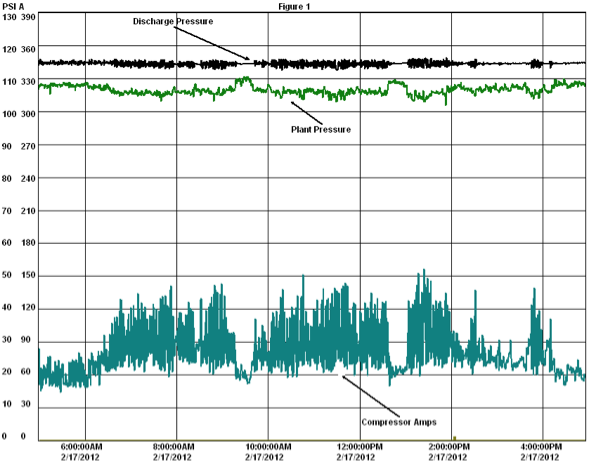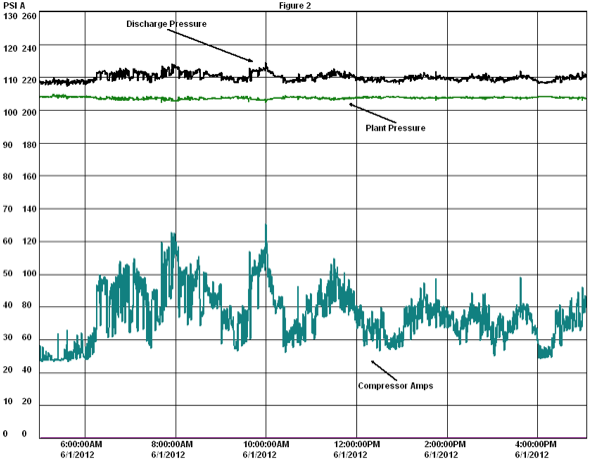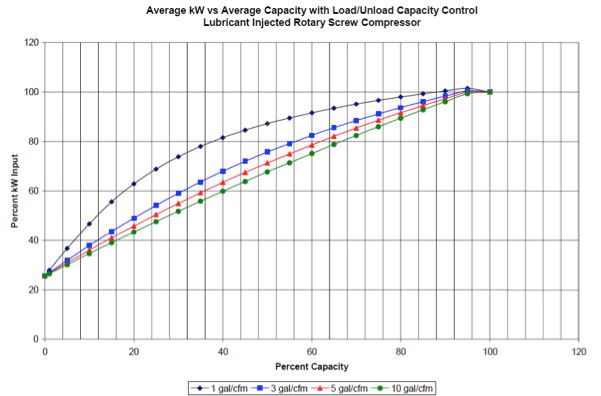Where Compressors Sense Pressure
All air compressors must sense pressure for control purposes to ensure the pressure they produce is maintained within certain limits. An uncontrolled system with high pressure would overload the compressor motor, cause catastrophic damage to compressed air equipment, and would consume significant energy. Uncontrolled low pressure would obviously cause major production problems in a plant and would not be desired. The goal of any compressed air system control is to main a constant stable pressure, not too high so as to cause increased energy consumption, and not to low so as to affect production conditions.
The control sensing point in an air compressor is often located before the air cooler or alternately at the compressor discharge, just inside the compressor package. Regardless of the location the compressor control will act to maintain a regulated pressure at that exact point, but the pressure at this location may be very different than the actual plant pressure.
The pressure differential across air treatment system; the air dryer and filters, will cause a sag in plant pressure causing a deviation in plant pressure, even though the compressor discharge pressure may be holding steady. A control point location inside the compressor package cannot compensate for this sag, even compressors with very expensive and precise VSD controls. Figure 1 shows the sag across the treatment system associated with a 150 HP VSD controlled compressor. It can be seen that this compressor does a very good job in maintaining a very accurate pressure at its discharge, however the plant pressure sags to as low as 102 psi during high flows.
Because the critical pressure applications in this plant require at least 100 psi the compressor discharge pressure must always be maintained at a higher than desired pressure so there will be enough pressure to overcome the sag during plant peaks. The plant peaks, however, occur a small percentage of the time which means for a large percentage of the time the discharge and pressures are higher than they need to be to maintain the minimum acceptable pressure. This causes higher average discharge and plant pressure, reducing system efficiency.

Figure 1: Compressor Discharge pressure is precise but plant pressure sags if sensing is at the compressor discharge
Remoting the Sensing
If the pressure sensing is relocated to downstream of the air dryer and filters the compressor will maintain a very accurate plant pressure by regulating the discharge pressure up or down at the time it is needed to compensate for the pressure differential caused by the varying flow. This adjustment keeps the plant pressure very flat, as is desired with a VSD compressor, rather than allowing the plant pressure to sag during high flow. The discharge pressure only goes to high levels when the occasional plant peaks occur, but overall the average discharge pressure levels are lower than before the change. The pressure setpoint of the air compressor can be set at a level slightly higher than the minimum pressure required by the critical plant pressure, in the case of Figure 2 the average plant pressure is 103 psi which is 4 psi lower than the previous average plant pressure of 107 psi. The average compressor discharge pressure is now 110 psi, which is 5 psi lower than the previous condition. The resulting energy saving due to the relocation of the sensing is about 5% which saves about $2,000 in energy costs per year, paying back the cost of the change in about 6 months. As can be seen in Figure 2, relocating the sensing has also better stabilized the VSD operation in that it has slowed the compressor response cycles making it easier for the compressor to maintain stable pressure. This is because the compressor now “sees” a large storage receiver located downstream of the air dryer and does not have to “look through” the dryer and filters.

Figure 2: Using remote sensing provides constant plant pressure and more stable compressor operation
Benefits to Fixed Speed Compressors
Relocation of the sensing to downstream of the compressor cleanup can better stabilize the compressor control for fixed speed compressors too. Consider a load/unload compressor that might have a 10 psi wide pressure band and well sized large storage of 5 gallons per cfm located at the discharge of the air dryer. If the air dryer and filters have 8 psid pressure differential the storage receiver will only “see” a pressure fluctuation of 2 psi during the load/unload cycles. This results in the storage receiver being 80% less effective in reducing the compressor load/unload cycles, or in essence having the effective equivalent of being a receiver sized at 1 gallon per cfm. Looking at Figure 3, a compressor loaded at 60% average capacity would consume 92% of its full load power at this less effective level rather than 78% if it could “see” the whole receiver capacity. Relocating the pressure sensing in this case could save 15% due to more efficient reduced compressor cycles if the average discharge pressure was adjusted and maintained at the same level as before.

Figure 3: Compressor efficiency depends on the size of effective storage.
Cautions About Remote Sensing
If you are considering relocating your compressor sensing location there are some cautions to be considered. Because the modified air compressor is not sensing pressure at its discharge anymore, if someone inadvertently closes the compressor discharge valve, or a filter or dryer plugs up, some excessive pressures may develop that could damage an air compressor or cause a catastrophic failure of auxiliary equipment. Also, some compressors may sense pressure differential across their internal oil separators using the now relocated pressure sensor, and since it is now sensing the pressure differential across the dryer and filters too, there may be a high separator differential alarm. For these reason it is important to carefully design in secondary local pressure protection at the compressor discharge to sense high pressure conditions and unload the compressor to keep it safely operating. Pressure alarms may also need to be recalibrated. Consultation with the compressor supplier or manufacturer is recommended to prevent these problems.
Often the best bet for remote sensing is to use a separate compressor controller that may be provided by the compressor supplier or some third party to provide the remote sensing while keeping the local compressor control sensors in place. These units are normally designed with pressure protection strategies to prevent local compressor discharge pressure issues. These controls can also provide intelligent operation of backup compressors, rotate compressors to share hours, and provide other benefits such as remote system monitoring. More information about these types of controls can be found in CAC’s seminar workbooks.